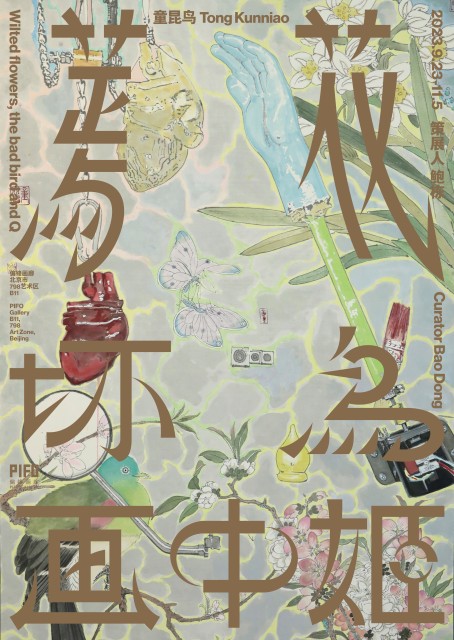Wilted Flowers, the Bad Bird, and Q
by Bao Dong
The art of today is essentially installation as what constitutes it is the fundamental elements of ready-made. Materially speaking, paints, canvases, frames, conceptualized images, symbols, subjects, and themes are all artifacts with historical value. What is even worse or more interesting is that—to make sense of art—art as a concept and the values of a single art piece must be set in a certain context along with other materials or conceptualized ready-made. Although painting in the traditional sense remains and is periodically being created, it has detached from the representational and expressive functions of its own. That being said, in a typological sense, most paintings of today have long since become installations.
Tong Kunniao’s most recent paintings can be readily described as installations since the images in his paintings are sourced from his previous installations, such as the figure of a cyborg human. Flowers and birds in Tong’s paintings can be attributed to the influence of traditional Chinese painting such as that of the Song dynasty. Stylistically, the brush-and-ink style is a combination of the careful realist gongbi technique and the interpretive, expressive xieyi style, one that adds a sensibility of illustration of today to it in terms of the placement and arrangement of objects. The frames and their ornate detailing outside the paintings together with the easels have enhanced the attributes of an installation in an archetypical sense. To put it another way, Tong begins by making a painting of an installation to create a new series of visual installations out of the images that have been designed for the installation and other images in the existing painting and eventually places the ready-made work on an easel. Interestingly, the installation characteristics of a painting are fully exposed if the concept of “easel painting” is brought to light intuitively. In essence, the original themes, artistic language, style, and artistic genres are profoundly disturbed yet simultaneously unified in the coherent, natural style of Tong Kunniao.
So, what defines the style of Tong Kunniao? Makeshift things, low technology, artistic bric-a-brac, folklore design, obsession with machines, hoarding, rap, dialect, “soil-flavored” bodies (figuratively meaning either tacky cool or outdated, cringe-worthy), put-up-or-shut-up attitude, and a lot more. In fact, all of this seemingly chaotic yet vibrant kaleidoscope of things is collectively turned into the aesthetics of a childishly, unreasonable being. Ever since Tong created the “Screaming Bird”, he has synthesized the “bad bird” style —which combines covert and overt badness— by paralleling two pleasures: one is the naughty pleasure of an eight/nine-year-old child, which attaches to urinating, defecation, and flatulence, the other is the provocative pleasure as depicted by Marcel Duchamp in “The Large Glass” (also known as “The Bride Stripped Bare by Her Bachelors, Even”).
In the world of contemporary art, such a sense of “badness” can be understood as astuteness since it is at odds with the conventional norms and not based on principles, however, it reflects a kind of personal experience that has yet been described, revealing a sense of Romanticism that emphasizes the primacy of the return to child innocence without being controlled against the backdrop of excessive policies in place in art and society. Once appeared—or more specifically, elaborated— in the paintings that can be described as playful or cynical, the anti-grand-narratives attitude —after shrugging off the binary understanding of political correctness with Chinese characteristics, has re-emerged in a sincere, progressive manner other than in the form of a new “gaudy aesthetics” that is rather speculative. This time, however, such an attitude points to the dual realm of the material world and the wellbeing of individuals, which is constantly involuted.
At one point, romanticism in European art turned towards multi-layered heterogeneity of location, ethnicity, and religion to open up other opportunities for the ever- increasingly closed system. Similarly, the revival of ancient traditions and the quest for the lost rituals in the wilderness undergone by ancient China opened the pathway to transformation and change. The radicalism of today has carried all kinds of de-centering, deontological beliefs and thoughts to extremes in both subject matter and form. Here we come to see that Tong Kunniao’s artistic practice, in terms of subject matter, has conceptualized the broad equality of human, nature, and machine; in terms of form, the artist has developed a deontological, even de-mechanical type of artistic practice. Such a disruptive strategy appears to remind us of Futurism and Dadaism which were popular one hundred years ago or so, making us wonder if a new nihilistic avant-garde movement can ever happen again.
September, 2023
Translated from Chinese by Ma Zhengtang.
Tong Kunniao, Chinese, b.1990, Changsha, Hunan Province, received his BFA from No.3 Studio, Department of Sculpture at the Central Academy of Fine Arts in 2015. In 2016, he went to graduate school and dropped out in the same year. He currently lives and works in Beijing.
Bao Dong, born in Anhui in 1979, graduated from the Art History Department of the Sichuan Fine Arts Institute in 2006. He is an active art critic and curator of the new generation in China, co-founder and artistic director of Beijing Contemporary Art Fair.

